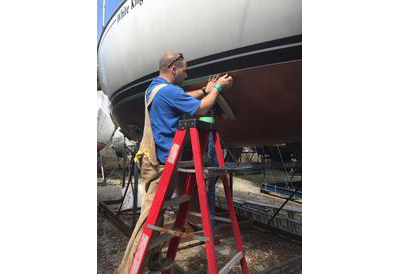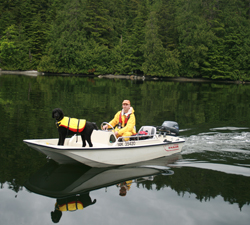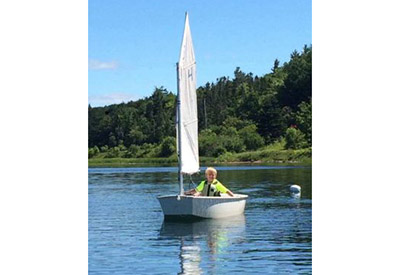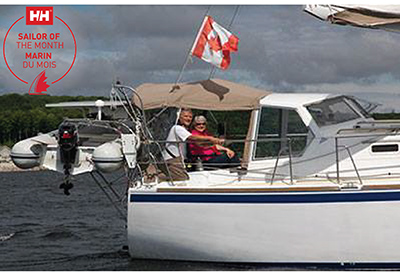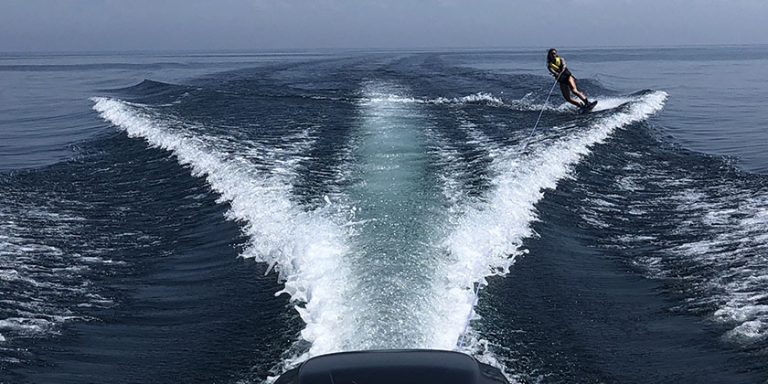Tackle Box Basics: A non-anglers guide to fishing
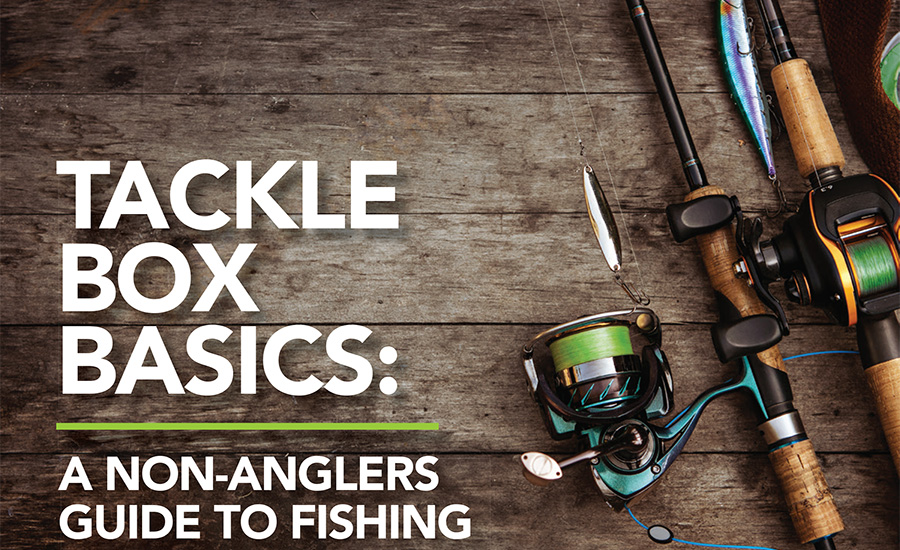
Right off the bat, let me reiterate what I say every time we include fishing on an episode of Water Ways: I’m not very good. But I do really enjoy it and I love picking the brains of people around me to get better.
by: Steven Bull (Host – Water Ways TV)
Right off the bat, let me reiterate what I say every time we include fishing on an episode of Water Ways: I’m not very good. But I do really enjoy it and I love picking the brains of people around me to get better.
Luckily, some of those brains are pro anglers like Bob Izumi; teen fishing phenom and TV host, Averie Rose Bonin; and my father-in-law who ran a charter business on the Great Lakes, so the advice I gather is as solid as it comes. The good news is that it’s remarkably simple – and affordable – to get started.
“Don’t overthink it. That’s number one,” says Brian Armitage, who ran J.J. Charters in the 1980s and early 1990s. “This is supposed to be fun!”
Armitage, my father-in-law, has an embarrassment of riches in terms of tackle collected over the years but when it was time to outfit our boat for his grandson to start fishing, there was only a handful of items that he said were vital.
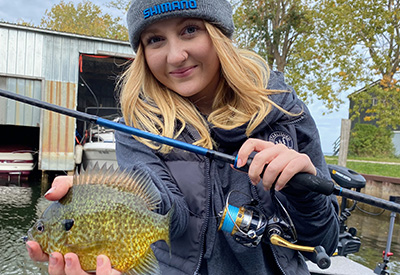 “To be honest, a hook, a bobber and a worm will get you fish just about anywhere, anytime, if you’re not worried about species or size. Especially when fishing with kids, it’s the catch that’s the thrill, not the size or species that matters. It’s all about the smiles.”
“To be honest, a hook, a bobber and a worm will get you fish just about anywhere, anytime, if you’re not worried about species or size. Especially when fishing with kids, it’s the catch that’s the thrill, not the size or species that matters. It’s all about the smiles.”
Averie Bonin
The only other item he considers ‘vital’ are needle nose pliers or something to remove hooks that are deep-set or in the mouths of sharp-toothed fish like Northern Pike or Muskie. But the smaller fish are what beginners are more likely to catch.
“If you’re looking for a fun and easy way to get started with fishing, panfishing is the perfect activity,” says Averie Rose Bonin, the 16-year-old host of ‘Hooked’ on Bell Fibe TV and World Fishing Network. “Giant bluegill, crappie, and sunfish are great species to target because they are plentiful and easy to catch.”
As for gear, she says simple is best for newbies.
“Start simple with a bobber, small hooks, and worms, and then branch out and try new gear and techniques like small jig heads or drop-shot rigs.”
 Legendary Canadian angler, Bob Izumi, echoes that – which is good news in an era where everything seems to be getting more expensive by the day.
Legendary Canadian angler, Bob Izumi, echoes that – which is good news in an era where everything seems to be getting more expensive by the day.
“You can get started with $50 or under,” he explained. “When it comes to rods and reels, there are so many different levels (of price). Just shop around.”
Brian Armtiage with grandson, Wilson.
LIVE BAIT vs. LURES
The advantage to live bait is that it’s real food that fish actually eat. It has smells, movement and, yes, blood that are irresistible. They aren’t realistic; they’re real.
The upside is you’re almost guaranteed to have bites. The downside is three-fold. You need to have somewhere to get it (there may not be a bait shop nearby), it doesn’t last forever (you can’t store live bait for a long period of time without special equipment), and you have to know how to put it on the hook properly (and some don’t want to deal with touching live bait to begin with!).
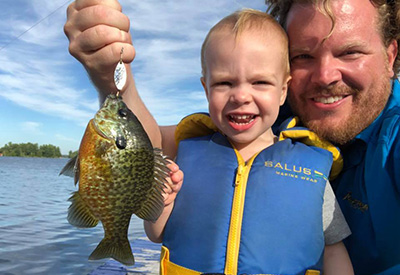 If you find a local bait shop and are going fishing that same day, you can simply Google how to deal with the last point. There are a ton of YouTube videos of how to bait your hook with fish, squid, minnows, worms and more.
If you find a local bait shop and are going fishing that same day, you can simply Google how to deal with the last point. There are a ton of YouTube videos of how to bait your hook with fish, squid, minnows, worms and more.
My son, Wilson, with a pan fish. The first catch of his ‘career’.
But most of the time, the occasional angler isn’t doing a dedicated fishing trip but rather, is looking for a way to pass the time at a new anchorage, find themselves near the water on land, or have grandkids visiting and they are looking for an activity.
In those cases, artificial lures are the way to go. They are easy to find in-store or order online. And, for many styles, the hook is already in place. The downside is that they don’t look, smell, or ‘act’ exactly as live baits do.
“If you put a live worm on your hook, it takes care of the whole ‘looking like a worm’ thing by itself,” Armitage explains. “But I understand that some people don’t like touching live bait or you haven’t planned on fishing and want to grab something from the tackle box. Lures work very well, and I’d say a couple rubber worms, a crankbait fish lure, and a spoon or two will cover your bases nicely and give you options if one isn’t getting results.”
 Izumi says that while the sky is the limit in terms of artificial lures, you don’t necessarily need the expensive and fancy ones, even if you go that route.
Izumi says that while the sky is the limit in terms of artificial lures, you don’t necessarily need the expensive and fancy ones, even if you go that route.
My son, Wilson, with a snook caught from a dock in Florida.
“I would recommend some smaller artificial lures if you just want consistent action,” he says. “Some of these new smaller soft plastic lures just seem to catch everything that’s out there. I would say the biggest thing is that smaller is better if you want consistent action, especially with youth who are new to it.”
The main takeaway is you don’t need much and don’t overthink it.
RODS, REELS and LINE
Ok, we’ve covered what’s at the end of the line and in the water. But what about the other end that’s in your hands?
Technically you don’t need one and could just hold the fishing line in your bare hands though, without gloves you’re sure to injure yourself with the thin line, it will get tangled and that isn’t how anyone really fishes anyway.
I think we can all safely assume that some sort of actual rod and reel are used by just about everyone. What then?
First, understand the difference. The rod is the long ‘stick’ and the reel is what the line is attached to, though when together people commonly just call it a fishing rod.
Walk into an outfitters or a large tackle and bait shop and you’ll be overwhelmed by the options and prices with the high-end, offshore gear – like for bluefin tuna – starting in the multi-thousand dollar range. The hardcore crowd and pros will customize their gear, but for you and I, we’re fine with the “over the counter” remedy.
This, like everything, comes down to not overthinking it. Get what works for you. A rod-and-reel sold together as a pre-assembled combination works for 95% of people. I bought a telescoping travel rod and reel for about $60 CDN nearly a decade ago and took it with me on TV shoots around North America. Where it was easy to get live bait – like just about anywhere in Florida – I’d use that but would take one spoon-style lure with me and managed to catch a bunch of fish over the years.
That “cheap” rod even landed my biggest-ever fish while in northern Saskatchewan: an 18-pound Northern Pike! (PHOTO BELOW). The point – bragging aside – is that the cheapest option I found that would fit in a carry-on landed me a trophy catch as good as a top-notch combo would have. I still have, and use that rod by the way.
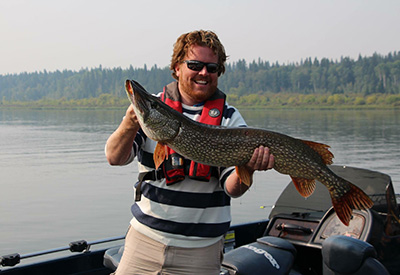 Finally, the line. This too can be overwhelming if you wade out of the safe rod-and-reel-combo waters. Big words like monofilament and fluorocarbon may scare you off. For the occasional angler like myself and many of you, this isn’t a massive concern. Nor is colour, in any real sense for the amateur.
Finally, the line. This too can be overwhelming if you wade out of the safe rod-and-reel-combo waters. Big words like monofilament and fluorocarbon may scare you off. For the occasional angler like myself and many of you, this isn’t a massive concern. Nor is colour, in any real sense for the amateur.
Steven’s monster Northern Pike caught with a telescoping travel rod.
Safe to go for the clear look and aim for a lower test – a term meaning how strong, and thus how thick, a particular line is. They are measured in weight based on tests of their tensile strength and so the bigger the fish, the higher the test you’ll need.
“It’s important to use lighter action rod reel and line,” says Izumi. “A 6- or 8-pound test line, which is thinner, will get more bites and be easier to cast for beginners.”
WHERE THE FISH ARE
Unless we’re talking about offshore fish like bluefin tuna or marlin, the simple rule is fish like structure. That structure can be rocks, docks, fallen trees, or coral reefs. Anything!
“Fish like to be around some sort of cover, like a breakwall or weeds,” says Izumi. “The contours of shorelines can be a good place to start.”
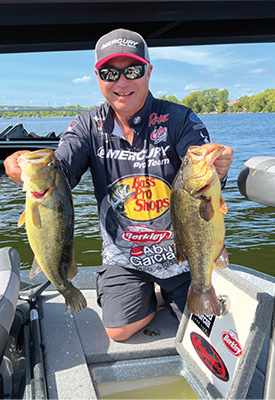 You’re more likely to have luck near the shore than in the middle of the lake. More water doesn’t mean bigger and better fish. Especially when we’re talking about bass or “panfish” like perch or bluegill, the small and fun ones for kids to catch.
You’re more likely to have luck near the shore than in the middle of the lake. More water doesn’t mean bigger and better fish. Especially when we’re talking about bass or “panfish” like perch or bluegill, the small and fun ones for kids to catch.
Bob Izumi
“These fish are typically grouped together in schools and feed on minnows, bugs, and plankton,” says Bonin, who has been making YouTube fishing videos since she was 11. “They can be found almost anywhere, from the Great Lakes to small ponds and reservoirs. You can fish them from shore or in a boat with a light action rod, light line, and a variety of rigs.”
In March 2022 I attended the Bassmaster Classic and was out on a media boat chasing the pros around Lake Harwell in South Carolina. The overwhelming majority of the time, they were fishing under docks of waterfront homes, under bridges and in sheltered bays. Proof that you don’t need to venture far offshore to land some trophy catches.
The final advice is to do what I do. Ask for advice!
“There’s not a charter captain worth their salt that would not share info with you,” Armitage says. “They may not tell their absolute favourite locations, as that’s their bread-and-butter, but as far as baits, lure colours and what is biting these days, they will help you out.”
At the end of the day, you need a hook attached to a line with some way to retrieve that line from the water. What’s on that hook is up to you. Just get out there and have some fun!
TACKLE BOX ESSENTIALS:
Rod & Reel – Lighter test line (6-8lbs) and a “basic” set-up is perfect for beginners
Hooks – Make sure you check if barbed hooks are permitted, some jurisdictions don’t allow them.
Needle nose pliers – Something to remove a hook if it’s set deep in the mouth, or in a fish with sharp teeth
Rubber Worms – Berkley PowerBait or similar work nicely,
Spoons – Generally metal lures with a single flat section that spins through the water dragging a hook
Weights – Your pliers will come in handy to squeeze these onto a line above a hook so it sinks better
Crankbait – Often shaped like fish with a big lip on the front to drag it down under the water
FISHING TERMS:
Jigging – Letting your line sink down in the water, using small movements to make the lure “dance”
Casting – throwing the bait/hook from you and slowly reeling it back in for the bait/lure to “swim” through the water
Trolling – Letting your bait/lure drag in the water behind a moving boat
Downrigger – Used to set bait/lures at a desired depth, commonly used for salmon fishing
Outrigger – Long poles that extend lines far out to the side of a trolling boat, generally only found on offshore ocean fishing boats


